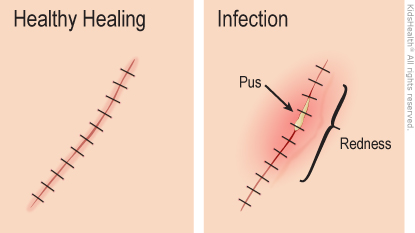Often a laceration (cut) needs stitches to bring the two sides of skin closer together. Some stitches need to be removed, but others dissolve on their own. Most cuts will leave a small scar. A healing cut can get infected, so the health care provider cleaned it carefully. You can help to prevent infection by taking good care of the cut as it heals.




The cut starts bleeding and doesn't stop, even after you apply light pressure.

Why do health care providers stitch cuts? Some small cuts can heal on their own. But for cuts that are large, wide, or bleeding a lot, health care providers need to use stitches to bring the edges of the cut closer together (called closing the cut).
What will happen to the stitches? Some stitches need to be removed by a health care provider. How long stitches need to stay in the skin depends on the kind of cut and where it is. Absorbable stitches dissolve on their own. Sometimes small white sticky tapes called butterfly bandages are put over the stitches to give them extra strength. These tapes loosen in a few days and fall off on their own.
Why does a cut get a scar? When the deeper layer of the skin is injured, the body uses a protein (collagen) to help fill in the cut area. The filled-in area becomes a scar. A scar can form even if a cut is fixed with stitches. Over time, some scars fade or get smaller.